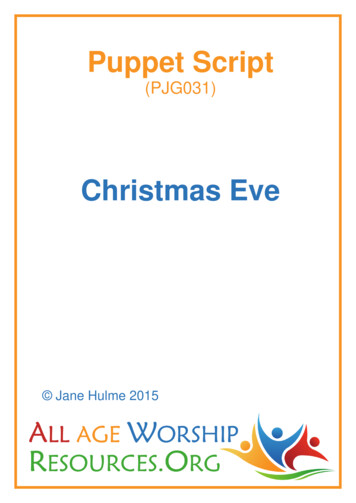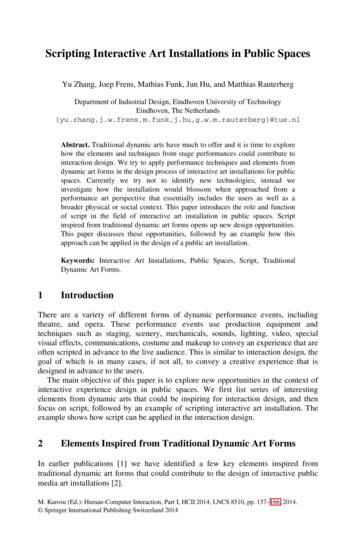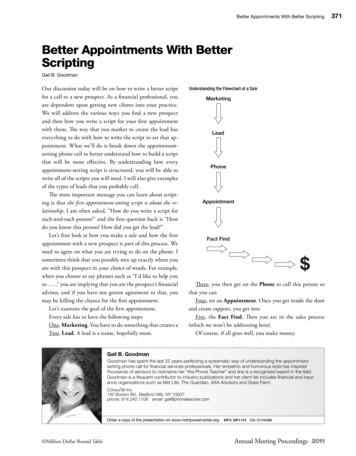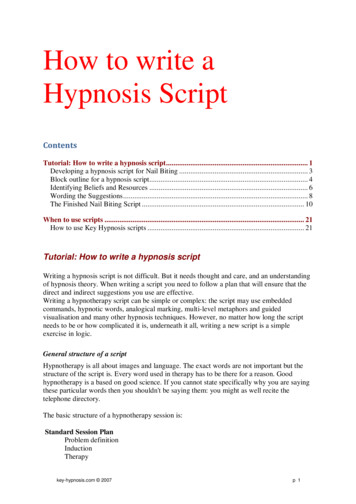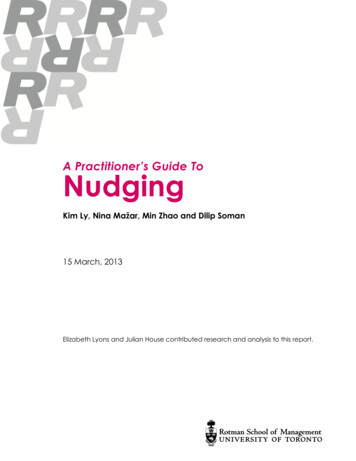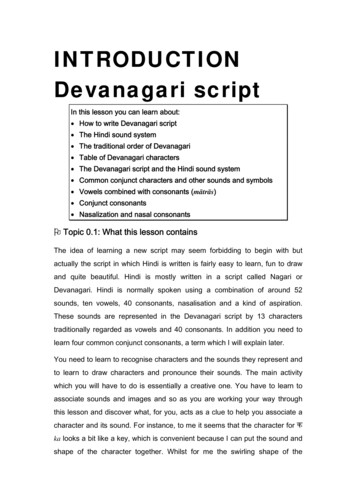
Transcription
INTRODUCTIONDevanagari scriptIn this lesson you can learn about: How to write Devanagari script The Hindi sound system The traditional order of Devanagari Table of Devanagari characters The Devanagari script and the Hindi sound system Common conjunct characters and other sounds and symbols Vowels combined with consonants (mātrās) Conjunct consonants Nasalization and nasal consonantsTopic 0.1: What this lesson containsThe idea of learning a new script may seem forbidding to begin with butactually the script in which Hindi is written is fairly easy to learn, fun to drawand quite beautiful. Hindi is mostly written in a script called Nagari orDevanagari. Hindi is normally spoken using a combination of around 52sounds, ten vowels, 40 consonants, nasalisation and a kind of aspiration.These sounds are represented in the Devanagari script by 13 characterstraditionally regarded as vowels and 40 consonants. In addition you need tolearn four common conjunct consonants, a term which I will explain later.You need to learn to recognise characters and the sounds they represent andto learn to draw characters and pronounce their sounds. The main activitywhich you will have to do is essentially a creative one. You have to learn toassociate sounds and images and so as you are working your way throughthis lesson and discover what, for you, acts as a clue to help you associate acharacter and its sound. For instance, to me it seems that the character for कka looks a bit like a key, which is convenient because I can put the sound andshape of the character together. Whilst for me the swirling shape of the
Introduction to Hindi Scriptcharacter छ cha reminds of churning, and so I can associate the characterand the sound.You should bear two things in mind as you study Devanagari script and Hindisounds. First, although Hindi is written in just a limited number of characters,traditionally 33 or 52 characters, they do in practice combine in quite a lot ofways, however, most of the common combinations are easy to learn once youknow the basic characters. Second, don’t worry if you can’t pronounce all thesounds correctly to begin with (or even hear the differences in some cases) asyou learn your ear will ‘tune in’ to the sounds and you will gradually learn topronounce them correctly.Topic 0.2 How to write Devanagari scriptTo practise writing Devanagari it is best to use lined paper and to write onalternate lines. Note the following points. Devanagari characters hang from a horizontal line (called the head stroke)written at the top of the character. Unlike English letters which are writtenup from a line below them. The body of the Devanagari characters should occupy about two thirds ofthe space between the lines. In general the first stroke, or strokes, in a character are written from the leftto the right and are then followed by any down strokes and finally the headstroke is added. Note that in some characters the head stroke is broken. The following pages show the characters with arrows added indicating thedirection of the strokes as they are drawn and the order they are drawn in. It is important to learn the correct stroke order for Devanagari characters aswhen, hopefully, you start to write quickly the character will be recognisableeven if its form gets more cursive than is the case for printed Hindi. It normally takes between three and five strokes to write a Devanagaricharacter. On separate sheets of paper practise writing the characters onthe following pages noting the order and direction of strokes indicated foreach character.
Introduction to Hindi ScriptTopic 0.3 The Hindi sound systemThe sound system (phonology) of modern spoken Hindi can be represented ina number of different scripts including Devanagari. In English Devanagari isoften called a syllabary, rather than an alphabet, because each Devanagaricharacter normally represents a consonant and a vowel combination or avowel on its own. Devanagari consonants are normally considered to have abasic form which consists of a consonant pronounced with an inherent ‘a’sound similar to the vowel sound in the English words but or son. In otherwords each Devanagari character normally represents a complete syllable.Devanagari is relatively easy to learn because it is largely phonetic, that is tosay that mostly the script is a representation of the actual sounds.Before starting to learn to pronounce Hindi you should be aware of two waysin which Hindi distinguishes sounds which are not familiar to English speakers.Most Hindi consonants are in pairs in which one form of the consonant isunaspirated and the second is aspirated. The unaspirated consonants arepronounced with no, or very little, out breath with the sound, and the aspiratedconsonants with a very strong out breath. Whereas in English almost allconsonants are partly aspirated.Hindi also distinguishes between dental ‘t’ and ‘d’ consonants and retroflex ‘t’and ‘d’ consonants. Dental consonants are made by touching the tip of yourtongue on the upper part of your top teeth, whereas retroflex consonants aremade by curling the tip of the tongue against the palate and then releasing it.Again English ‘t’ and ‘d’ sounds are somewhere between Hindi dental andretroflex consonants. As you practice you will start to hear the differences andgradually learn how to pronounce the different sounds for yourself.
Introduction to Hindi ScriptTopic 0.4: The traditional order of DevanagariIt is very useful to become familiar with the traditional order of Devanagari.This is because mother tongue speakers will tend to recite it to you in thisorder and because dictionaries are arranged in this order. You read the tableas if it were text, left to right, top to �स10ह11क़ख़ग़ज़फ़ऋड़Note that in the traditional order of Devanagari the characters modified byunder dots are not listed separately but regarded as variants of their basecharacters.
Introduction to Hindi ScriptTopic 0.5 Devanagari characters and their �aṛhaqaḵẖaज्ञ
Introduction to Hindi ScriptTopic 0.6 The Devanagari script and the Hindi sound systemThe sounds of spoken Hindi are generally written in Devanagari script, whichis also used to write Sanskrit, Nepali, and Marathi. The precise number ofDevanagari characters is not easy to work out.1 Sometimes people say therewere in Sanskrit 52 characters. In Hindi people often say there are 13 voweland 33 consonant symbols. However, it all depends what you define as acharacter, in practice there are 13 vowels, 33 consonants, four commonconjuncts and seven characters with dots under them that represent soundsnot found in Sanskrit.There are ten2 vowel sounds in Devanagari. All the vowels apart from अ ahave two written forms. The full form of a vowel is written when it appears atthe beginning of a word or when it directly follows another vowel. The mātrāform is a symbol that represents the vowel when it is pronounced in place ofthe अ a vowel which is considered to be inherent in each consonant. Themātrās are written variously above or below, or to the left or the right of theconsonant.अ a is similar to the u in but, as in अख़बारaḵẖbār ‘newspaper’.It has no mātrā form.आā is similar to the a in father, as in आदमीādmī‘man’.Its mātrā form is ा written after characters.1How many English letters are there? You may say 26, but then what about the capital letters,wouldn't that make 52? Also do you include characters like æ in the number of letters?2Eleven according to tradition, but ऋ ṛ is normally pronounced ri by most Hindi speakers.
Introduction to Hindi Scriptइi is similar to the i in sit, as in इमारत imārat ‘building’.Its mātrā form is ि mātrāwritten before characters. Note that even though itsform is written before characters, it is still pronounced after thecharacter.ई ī is similar to the ee in need, as in ईमानदार īmāndār ‘honest’. Its mātrāform is ी written after characters.उu is similar to the oo in book, as in उ र uttar ‘north’. Its mātrā form is ुwritten under characters except when it is written with र when it is written likethis रु.ऊū is similar to the oo in soon, as in ऊन ūn ‘wool’. Its mātrā form is ूwritten under characters except when it is written with र when it is written likethis रू.
Introduction to Hindi Scriptऋṛ is similar to ri in rip, as in ऋिष ṛṣi ‘a sage’. Its mātrā form is ृ writtenunder characters. In Sanskrit ऋ ṛ is a vowel sound, like r in purdy, but mostHindi speakers pronounce it as if it were the sound िर ri.एe is similar to the initial part of the sound of a in mane, as in एक ek ‘one’.Its mātrā form is े written above characters.ऐ ai is similar to the a in hay, as in ऐनक ainak ‘spectacles’.Its mātrā form is ै written above characters. Some Hindi speakers pronounceit like the diphthong ei in height.ओ o is a similar to the o in both, as in ओला olā ‘hail’.Its mātrā form is ो written after characters.
Introduction to Hindi Scriptऔ au is similar to the a in saw as in औरत aurat ‘woman’Its mātrā form is ौ written after characters. Some Hindi speakers pronounceit like the diphthong ou in ouch.क ka is similar to the k in speaker, as in कान kān ‘ear’. Note that there is lessbreath expressed when saying क ka than is normal with k in English. क़ qa (कka with a dot under it) is a similar sound produced further back in the throatthan क, Some Hindi speakers do not differentiate between the two sounds.ख kha is the aspirated form of क ka, as in खाना khānā ‘food’. To check if youare aspirating this consonant place your hand in front of your mouth when youpronounce it. As with all aspirated consonants, you should be able to feel abreath of air when you say it. Note that the h in the transliteration signifies thatit is aspirated, never say it as k-ha. ख़ḵẖa (ख़ with a dot under it) is a bit likethe sound ch in the Scottish word loch. It is found only in loan words fromPersian and Arabic and is often not distinguished from ख by many Hindispeakers.ग ga is similar to the g in go, as in गाय gāy ‘cow’. ग़ ḡa (ग with a dot underit) it is pronounced further back in the throat. It only occurs in Persian andArabic loan words and many Hindi speakers do not differentiate between ग gaand ग़ ḡa,
Introduction to Hindi Scriptघ gha is the aspirated form of ग ga, as in घर ghar ‘house’. Like ख kha youbreathe out while saying it.ङ ṅa is similar to the ng in king, as in अंगूर aṅgūr ‘grape’. It does not occur atthe beginning or end of words and occurs only as the nasalization of theconsonants: क ka, ख kha, ग ga and घ gha.च ca is similar to the ch in church, as in चम्मच cammac ‘spoon’. This is thefirst of the palatal consonants. That is to say the tip of the tongue touches thepalate of the mouth as you are saying it.छ cha is the aspirated form of च ca, as in छत chat ‘roof/ceiling’. It ispronounced a little like the ch in church-hill but strongly aspirated.ज ja is similar to the j in the jail, as in जगह jagah ‘place’.ज़ za ( ज with a dot under it) is similar to the z in zebra, This sound occursonly in English, Arabic and Persian loan words in Hindi. Some Hindi speakersdo not distinguish between the pronunciation of ज and ज़.
Introduction to Hindi Scriptझ jha is the aspirated version of ज ja, as in झोला jholā ‘shoulder bag’. It issimilar to the -dgeh- in hedgehog. There are two variant forms of thischaracter but the variant झ is more common in printed in Hindi.ञ ña is similar to the n in inch, as in पंजाब pañjāb ‘Panjab’. It is pronouncedwith the back of the tongue touching the roof of the mouth. It does not occur atthe beginning or end of words and occurs only as the nasalization of theconsonants: च ca छ cha ज ja and झ jha.ट ṭa is a form of t sound, as in टोपी ṭopī ‘a cap or hat’. When saying ट ṭa thetip of the tongue should touch the ridge of the mouth and then be flicked back.ठ ṭha is the aspirated version of ट ṭa, as in ठीक ṭhīk ‘fine, okay’, It is slightlysimilar to the t in train, but is pronounced with the tip of the tongue touchingthe ridge of the mouth and is strongly aspirated.ड ḍa is a little like the d in hard, as in िडब्बा ḍibbā ‘box, container’. The tongueshould touch the ridge of the mouth while saying it and then be quicklyflapped down. ड़ ṛa (डwith a dot underneath it) is type of r sound. To sayड़ ṛa the tongue should touch the roof of the mouth before quickly flappingdown during the production of the sound. Some Eastern Hindi speakerspronounce it like र ra, some Western Hindi speakers pronounce it prettymuch like ड ḍa.
Introduction to Hindi Scriptढ ḍha is the aspirated version of ड ḍa, as in ढाबा ḍhābā ‘a small restaurant’.It should be pronounced like ड ḍa but strongly aspirated. ढ़ ṛha (ढ ḍha with adot under it) is the aspirated version of ड़ ṛa, It should be pronounced like ड़ṛa but strongly aspirated.ण ṇa is a n said fairly far back in the mouth, as inण brāhmaṇ ‘Brahman’.As a consonant in its own right ण ṇa does not occur at the beginning of words.It also occurs as the nasalization of the consonants: ट ṭa ठ ṭha ड ḍa ढ ḍha.त ta is similar to the t in time, as in तश्तरी taśtrī ‘saucer’. When saying त tathe tip of the tongue should touch the base of the upper teeth.थ tha is the aspirated partner of त ta, as in थाली thālī ‘a kind of plate’ . Itshould be pronounced like त ta but strongly aspirated.द da is similar to the d in does, as in दरवाज़ा darvāzā ‘door’. When saying दda touch the base of the upper teeth with the tip of the tongue.
Introduction to Hindi Scriptध dha is the aspirated form of द da, as in धन्यवाद dhanyavād ‘thank you’. Itshould be pronounced like द da but with a strong out breath.नna is similar to the n in not, as in नाक nāk ‘nose’. When saying न na yourtongue should touch the base of the upper teeth. Note: it is important to put alittle loop in the
Introduction to Hindi Script 2 Topic 0.6 The Devanagari script and the Hindi sound system The sounds of spoken Hindi are generally written in Devanagari script, which is also used to write Sanskrit, Nepali, and Marathi. The precise number of Devanagari characters is not easy to work out.1 Sometimes people say there were in Sanskrit 52 characters. In Hindi people often say there are 13 vowelFile Size: 266KBPage Count: 24




